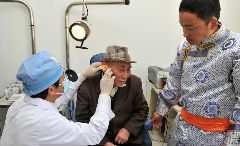China’s fiscal spending on healthcare up 10% in 2016
2017-02-09
cgtn.com
Healthcare expenditure in China grew in 2016 as fiscal spending increased by 10 percent year-on-year to reach 1,315 billion yuan, according to China’s Ministry of Finance (MOF).
Medical treatment and public health stood out as the bright spot in China’s fiscal spending effort to propel growth. The increase in medical care expenditure comes at a time growth in fiscal revenue was slowing, as the country maintained a proactive fiscal policy to stabilize economic growth.
“Only by solving problems in sectors like education and medical services can we truly bring reassurance to the average people,” said Liu Shangxi, Dean of the Chinese Academy of Fiscal Sciences.
Spending on healthcare accounted for seven percent of the overall fiscal spending, owing to China’s on-going supply-side reforms.
“Supply-side reform is reflected heavily in the public service area, as it is closely attached to people’s livelihood,” Liu explained.
The reforms, which aim at reducing overcapacity in traditional heavy industries such as steel, coal and aluminum, have led to large-scale lay-offs.
However, the issue was tackled by setting aside 100 billion yuan worth of funding to help relocate workers who became unemployed. The move includes over 40 percent increase in funds to help underprivileged groups.
“The government has played an active role in reallocating and training unemployed people in the industries with overcapacity issues,” Liu noted.
Tax reform is also another part of China’s fiscal stimulus. The country’s tax overhaul in 2016 led to the adoption of a value-added tax system with the aim of releasing companies’ tax burden.
Many observers have estimated that the country’s tax reform has saved companies over 500 billion yuan.



